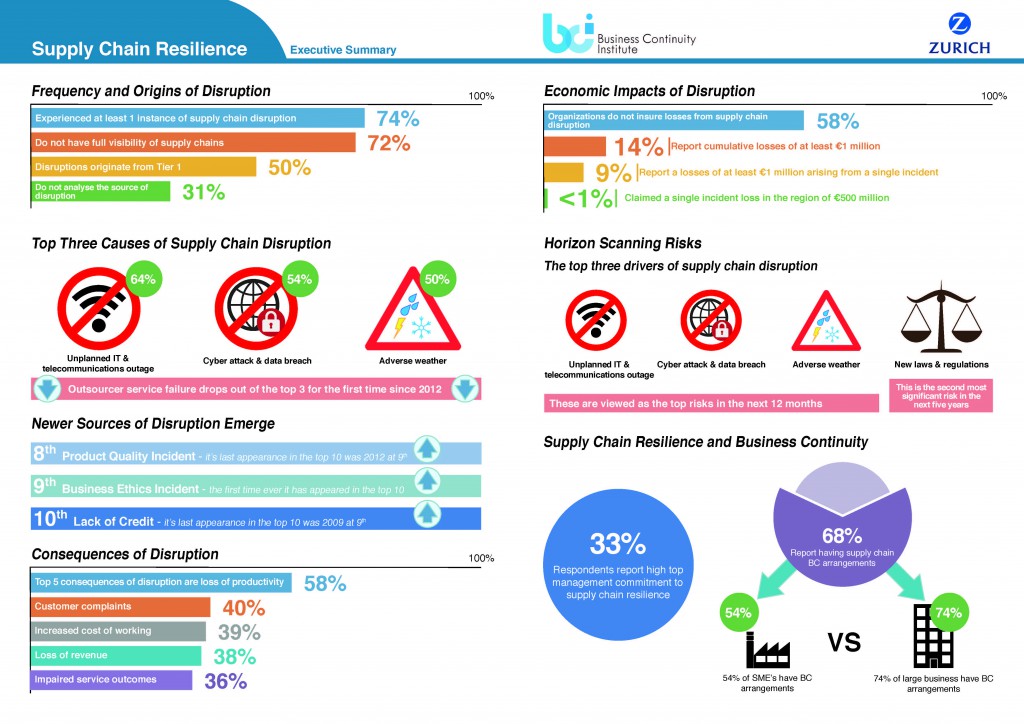Nearly one in 10 organizations don’t know who their key suppliers are. Let’s just let that mind-blowing fact sink in for a moment. One in 10. That means 10% have no way to mitigate the risk of severe supplier disruptions, have no way to prevent or prepare for potentially catastrophic issues, and have extremely limited supply chain visibility. They are essentially driving completely blindfolded. And isn’t that a terrifying thought? This little gem of a statistic comes courtesy of a recent report published by the Business Continuity Institute and supported by Zurich Insurance Group. The Supply Chain Resilience Report sheds a rather bleak light on the state of visibility among businesses. In addition to the 10% who have no idea who their key suppliers are, seven in 10 organizations admit to not having visibility over their full supply chain. While 74% of respondents have experienced at least one supply chain disruption, a disturbing 31% did not bother to investigate the cause. Again with the blindfold! Managing visibility across your supply chain cannot be a case of covering your eyes and pretending you don’t see it. The risks to your supply chain are real regardless of whether you choose to look or not. What’s more, the survey revealed half of the supply chain disruptions recorded occurred below the preliminary tier 1 supplier, adding difficulty in establishing where your organization lies within suppliers’ priorities. “Through our work with customers in this area, we have found that increasing visibility along supply chains and resilience are major sources of competitive advantage, “said Nick Wildgoose, Global Supply Chain Product Leader at Zurich Insurance Group. “Top management leadership is the key to overcoming silo thinking about supply chains within an organisation.” So what are these disruptions wreaking havoc on businesses’ supply chains? According to the report, the three most common causes of supply chain disruption were unplanned IT and telecommunications outages (64%), cyber-attacks and data breaches (54%), and adverse weather (50%). Some newer sources that have also emerged are product quality incidents, business ethics incidents, and lack of credit. Those same top three disruptions are also projected to be the top risks in the next 12 months, with new laws and regulations posing the second most significant risk to supply chains in the next five years. The consequences to not having full supply chain visibility are plentiful, but the study ranks the top five as loss of productivity (58%), customer complaints (40%), increased cost of working (39%), loss of revenue (38%), and impaired service outcomes (36%). Can your company really afford any of those?
Courtesy of the The Business Continuity Institute
But it isn’t all doom and gloom for businesses when it comes to supply chain visibility and risk. Another recent global survey report, also by Zurich, shows the potential business impact on small and medium enterprises (SMEs) who lose their main supplier. The results of this survey paint a much rosier picture. Of those surveyed, 55% reported they would not be affected at all if they were to lose their main supplier. That’s because 34% of them say they’re already using multiple suppliers. Another 25% said they’d only experience a short delay in production/deliver until they could find another supplier. To me, the results of these surveys don’t seem to be that consistent with each other, so I guess it really all does depend on who you ask. What I can tell you is that for those businesses who don’t have supply chain visibility, would be dramatically impacted if they lost their key supplier (for those who even know who that is!), and are running their business blindfolded when it comes to risk – be cautious. It’s often the things that we don’t see coming that cause us the most harm.






Leave a Reply